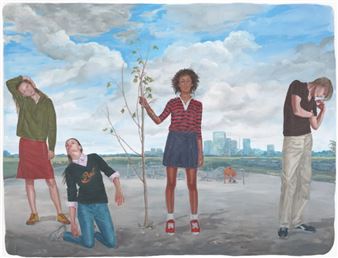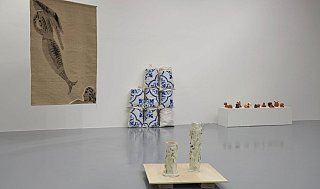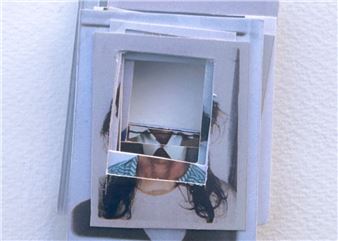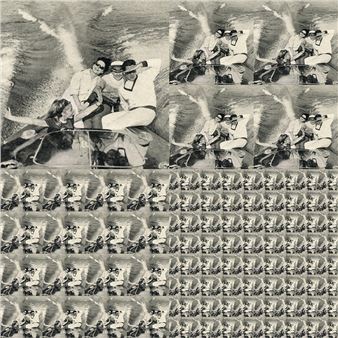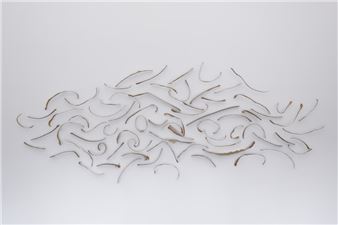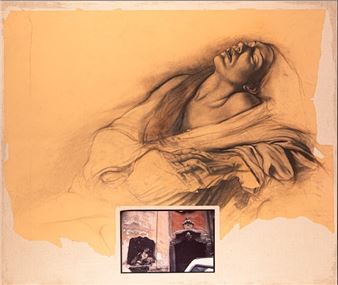History Never Really Says Goodbye
“Hasten, slowly” (festina lente). This motto of the ancient Roman emperor Augustus – found on a gold coin from his reign – is embodied by a crab and a butterfly on the obverse and reverse (slow and fast, heavy and light). Such a paradox is similar to the wisdom of the East, which renders precisely prudence and radicalism. When two extreme polars go hand in hand, we call it tension. Once the artist is willing to take the risk of mastering this delicate balance, the fascination of the work becomes apparent, and I can perceive this kind of weightlessness in Zhuo Qi’s works.
The artist “restores” Buddhist statues from China’s Five Dynasties and Ten Kingdoms period (A.D. 907-960) in glass bubbles. From which we perceive the temporal notion of “slowness”, an eternal splice while maintaining a geographical fluidity. Such style of damaged Buddhist heads, evident in Buddhism’s many rounds of rising and falling, represents the violent movements of religious icons in the East. Eventually, they established a distinct image out of the chaos and confusion. Over the years, such images became detached from its own aesthetic origins and followed Qi like ghosts. They enter the global language and became a metaphor of his “irreverent” as evidence of time and space. In his false “restoration”, Qi supplements its integrity with temporally and geographically irrelevant materials.
These works continue the dialectic of the Bubble-Game series exhibited in 2020: when he takes a religious icon from an ancient civilization as the material for his work, he dissolves the notion of “icon” in convention; Moreover, the creators of a religious icon was usually commonplace craftsmen who serve the public designated by the religion and who do not need to have their own free will or strivings of innovation. Wether in the case of Bushiest of Catholic icons, the creators do no have names, yet the idol was glorious and authoritative. Nowadays, as the times and space have changed, the humanistic image is free from the worship of beliefs and has generated its own culture. Hence, the artist becomes the primary creator of visual culture. Creativity is no longer reliant on divine power; thus, when the glass bubble casts over the remnants of the icon, not only does a sense of humor shines through, but the artist, as an individual, accomplishes his historical responsibility, which is to deliver freedom. In other words, art assumes this function when the sacred icon no longer evokes the world.
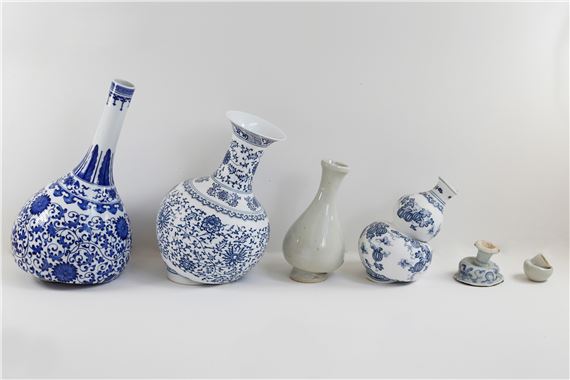
Recommended for you
“Hasten, slowly” (festina lente). This motto of the ancient Roman emperor Augustus – found on a gold coin from his reign – is embodied by a crab and a butterfly on the obverse and reverse (slow and fast, heavy and light). Such a paradox is similar to the wisdom of the East, which renders precisely prudence and radicalism. When two extreme polars go hand in hand, we call it tension. Once the artist is willing to take the risk of mastering this delicate balance, the fascination of the work becomes apparent, and I can perceive this kind of weightlessness in Zhuo Qi’s works.
The artist “restores” Buddhist statues from China’s Five Dynasties and Ten Kingdoms period (A.D. 907-960) in glass bubbles. From which we perceive the temporal notion of “slowness”, an eternal splice while maintaining a geographical fluidity. Such style of damaged Buddhist heads, evident in Buddhism’s many rounds of rising and falling, represents the violent movements of religious icons in the East. Eventually, they established a distinct image out of the chaos and confusion. Over the years, such images became detached from its own aesthetic origins and followed Qi like ghosts. They enter the global language and became a metaphor of his “irreverent” as evidence of time and space. In his false “restoration”, Qi supplements its integrity with temporally and geographically irrelevant materials.
These works continue the dialectic of the Bubble-Game series exhibited in 2020: when he takes a religious icon from an ancient civilization as the material for his work, he dissolves the notion of “icon” in convention; Moreover, the creators of a religious icon was usually commonplace craftsmen who serve the public designated by the religion and who do not need to have their own free will or strivings of innovation. Wether in the case of Bushiest of Catholic icons, the creators do no have names, yet the idol was glorious and authoritative. Nowadays, as the times and space have changed, the humanistic image is free from the worship of beliefs and has generated its own culture. Hence, the artist becomes the primary creator of visual culture. Creativity is no longer reliant on divine power; thus, when the glass bubble casts over the remnants of the icon, not only does a sense of humor shines through, but the artist, as an individual, accomplishes his historical responsibility, which is to deliver freedom. In other words, art assumes this function when the sacred icon no longer evokes the world.

 ARTISTS
ARTISTS







